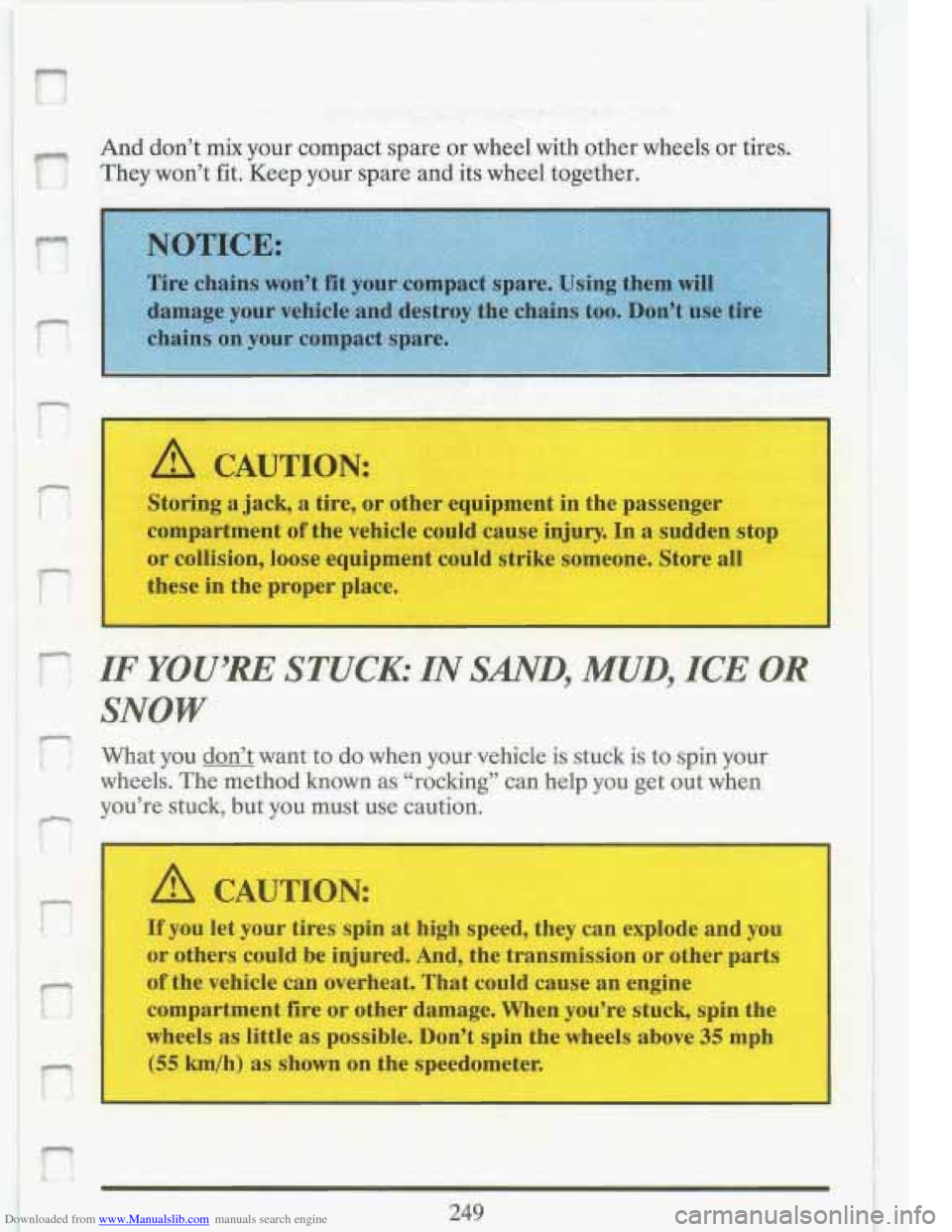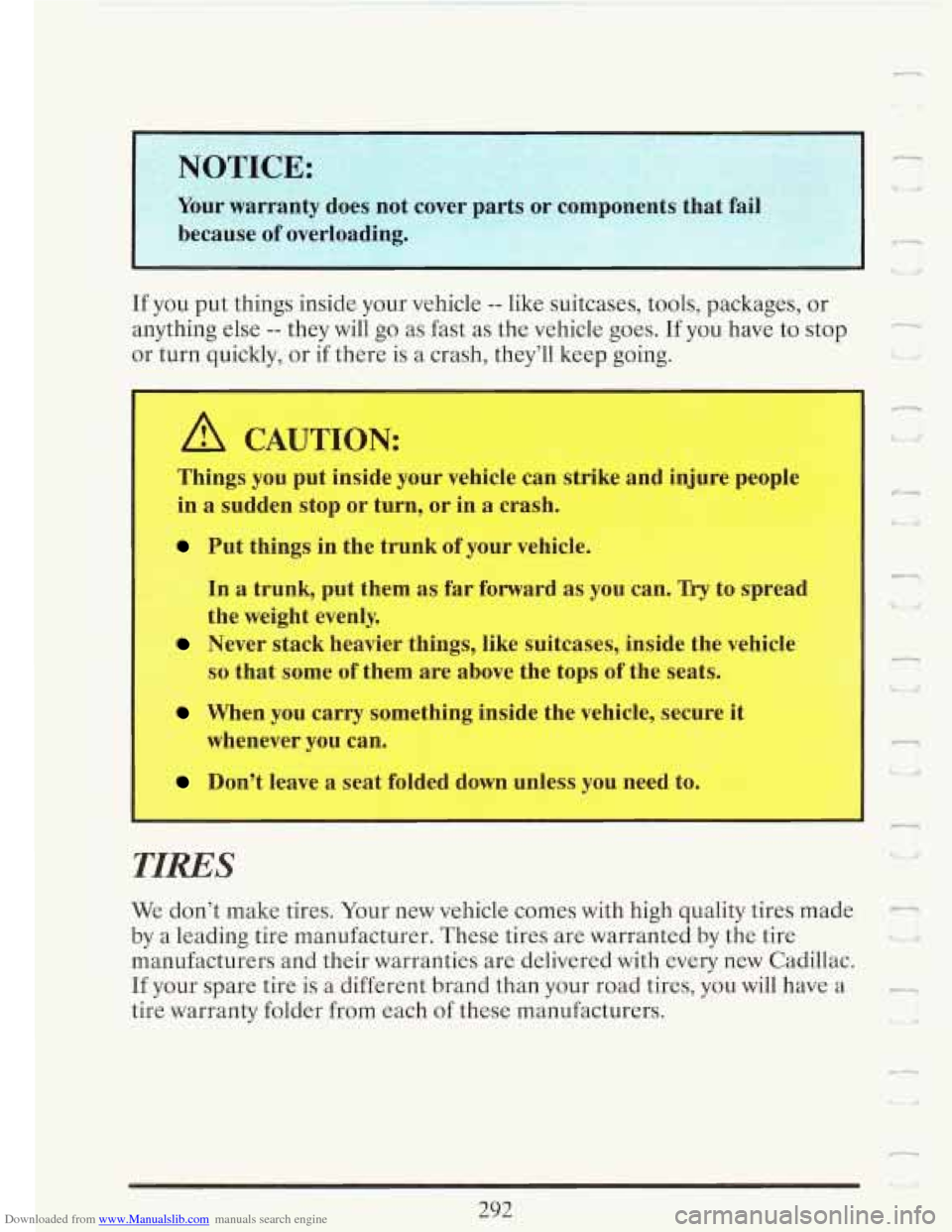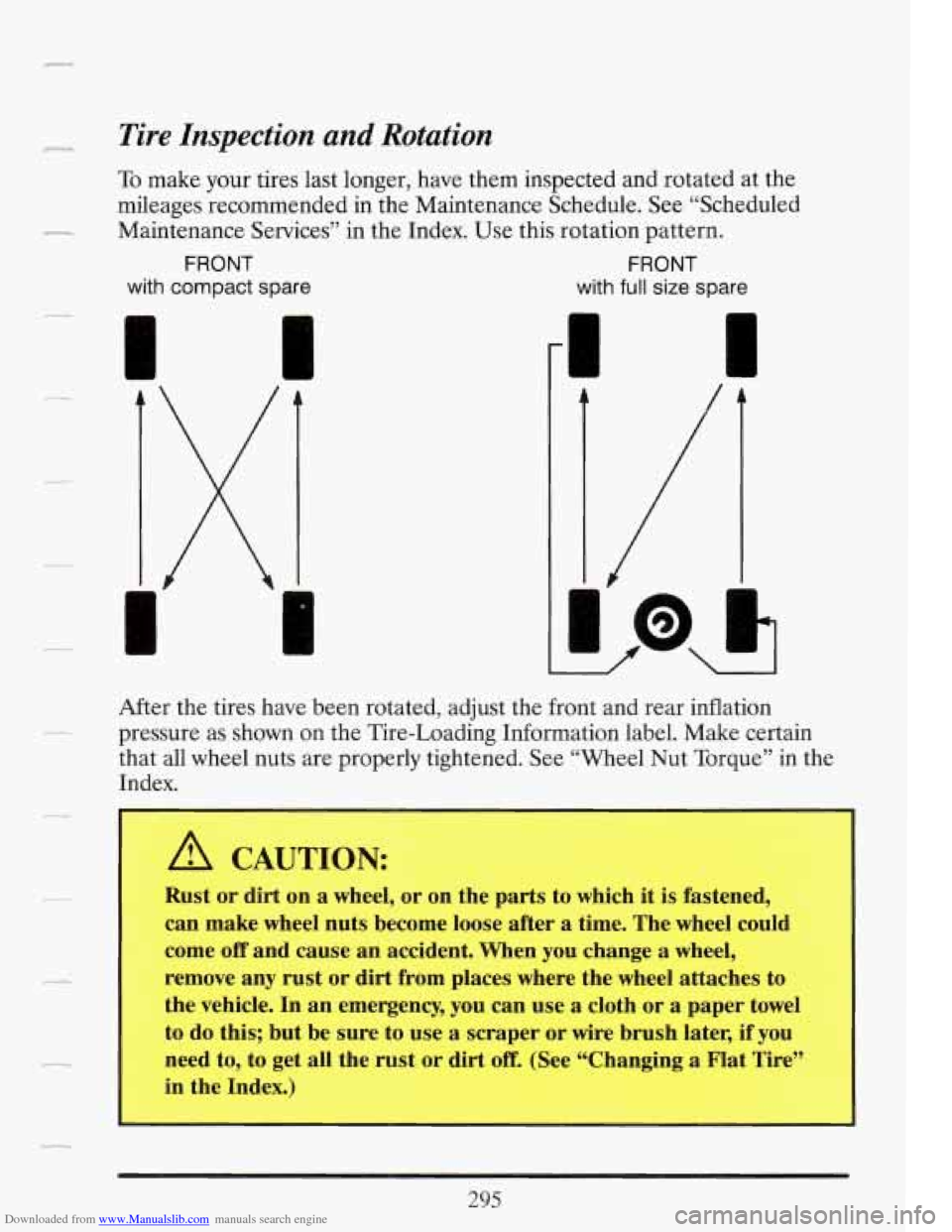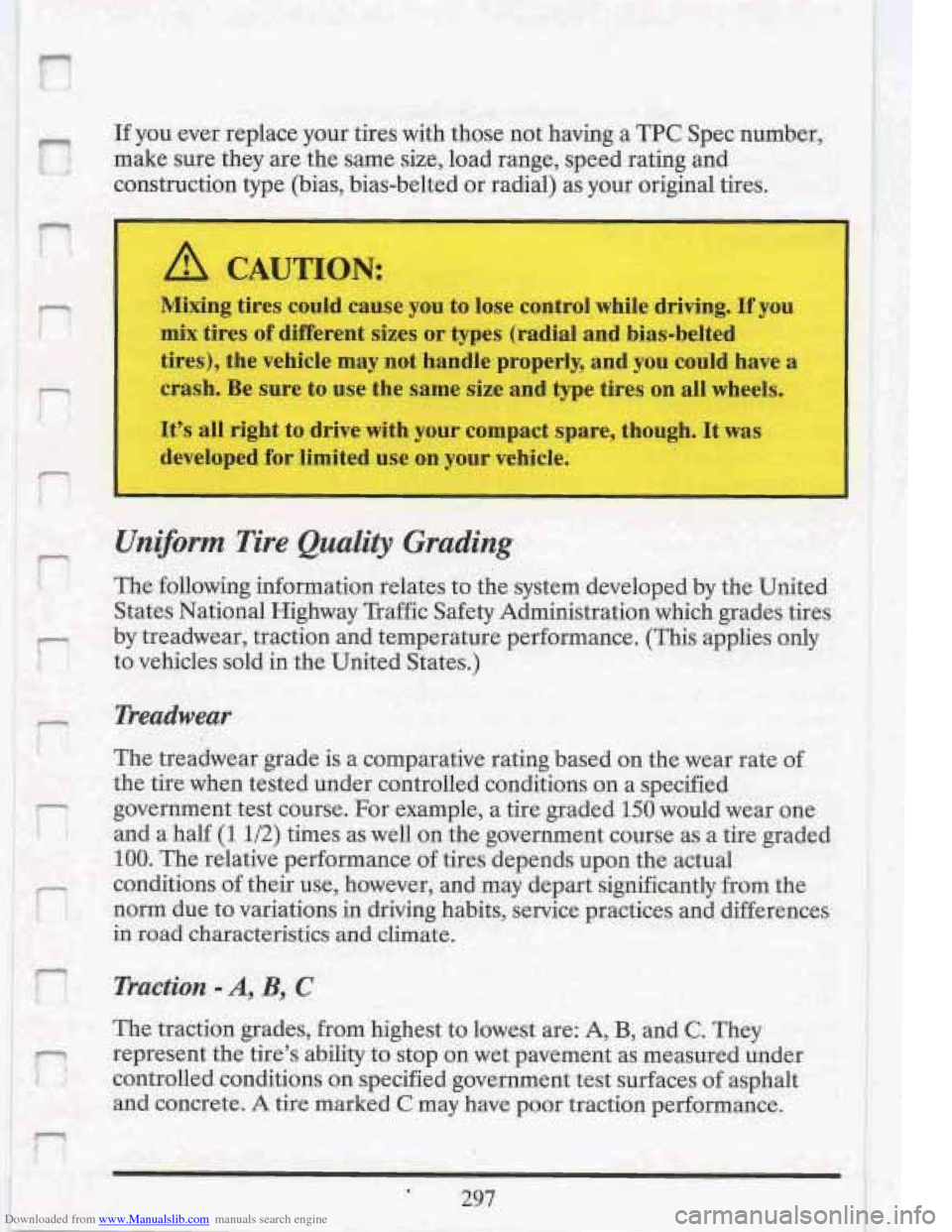Page 256 of 386
Downloaded from www.Manualslib.com manuals search engine Raise the vehicle by rotating the wheel wrench clockwise. Raise the
vehicle far enough off the ground so there is enough room for the spare
tire to fit.
Remove the wheel nuts and take off the flat tire.
- -
A CAUTION:
Rust or dirt on the wheel, or on the parts to which it is fastened,
can make the wheel nuts become loose after
a time. The wheel
could come
off and cause an accident. When you change a wheel,
remove any rust or dirt from the places where the wheel
attaches to the vehicle. In an emergency, you can use
a cloth or a
paper towel to do this; but be sure to use a scraper or wire
brush later, if you need to, to get all the rust or dirt
off.
U
I
n I " ,
-1
Page 259 of 386
Downloaded from www.Manualslib.com manuals search engine r
Tighten the wheel nuts firmly in a criss-cross sequence as shown.
A CAUTION:
A wheel can become loose and even come off if the wheel nuts
aren’t tightened properly. This could lead to an accident. Stop
as soon as you can and have the wheel nuts tightened with a
torque wrench.
Don’t try to put a wheel cover on your compact spare tire. It won’t fit.
replaced.
- Store the wheel cover in the trunk until you have the flat tire repaired or
r
245
Page 262 of 386
Downloaded from www.Manualslib.com manuals search engine Align the upper
locator pins and insert
-
the pins into the holes. .
n
Push the handles up to lock the skirt in place.
COMPACT SPARE TIRE
Although the compact spare was fully inflated when your vehicle was
new, it can lose air after a time. Check the inflation pressure regularly. It
should be
60 psi (420 kPa). The compact spare is made to go up to 3,000 -
miles (5000 km), so you can finish your trip and have your full-size tire i* u
repaired or replaced where you want. Of course, it’s best to replace your I
spare with a full-size tire as soon as you can. Your spare will last longer
and be in good shape in case you need it again.
Your anti-lock brake system warning light may come on when
you are
driving with a compact spare. See “Anti-Lock Brake System Warning
Light” in the Index.
Don’t use your compact spare on some other vehicle.
248
Page 263 of 386

Downloaded from www.Manualslib.com manuals search engine And don't mix your compact spare or wheel with other wheels or tires.
They won't
fit. Keep your spare and its wheel together.
. - ':.-
'. * , F, . - ;,:: .-
Storing a jack, a tire, or other equipment in the passenger
compartment of the vehicle could cause injury. In
a sudden stop
or collision, loose equipment could strike someone. Store
all
these in the proper place.
,.-IF YOU'RE STUCK: IN SAND, MUD, ICE OR
at you don't want to do when your vehicle is stuck is to spin your
wheels. The method known
as "rocking" can help you get out when
Tw're stuck, but you must use caution.
A CAUTION:
If you let your tires spin at high speed, they can explode and you
or others could be injured. And, the transmission
or other parts
of the vehicle can overheat. That could cause an engine
compartment fire or other damage. When you're stuck, spin the
wheels as little as possible. Don't spin the wheels above
35 mph
(55 km/h) as shown on the speedometer.
I
i
Page 306 of 386

Downloaded from www.Manualslib.com manuals search engine Y~I
1 DTICE
’I
because of overloading.
If you put things inside your vehicle -- like suitcases, tools, packages, or
anything else
-- they will go as fast as the vehicle goes. If you have to stop
or turn quickly, or if there is a crash, they’ll keep going.
A CAUTION:
Things you put inside your vehicle can strike and injure people
in
a sudden stop or turn, or in a crash.
Put things in the trunk of your vehicle.
In
a trunk, put them as far forward as you can. Try to spread
the weight evenly.
so that some of them are above the tops of the seats.
When you carry something inside the vehicle, secure it
Never stack heavier things, like suitcases, inside the vehicle
whenever
you can.
Don’t leave a seat folded down unless you need to.
ic.
TIRES
We don’t make tires. Your new vehicle comes with high quality tires made
by a leading tire manufacturer. These tires are warranted by the tire
manufacturers and their warranties are delivered with
every new Cadillac.
If your spare tire is a different brand than your road tires, you will have a
tire warranty folder from each of these manufacturers.
292
-1
CI
Page 308 of 386
Downloaded from www.Manualslib.com manuals search engine ea
When to Check Check your tires once a month or more.
Don't forget your compact spare tire. It should be at
60 psi (420 kPa).
How to Check Use a good quality pocket-type gage to check tire
pressure. Simply looking at the tires
will not tell you the pressure,
especially
if you have radial tires -- which may look properly inflated even
if they're underinflated.
If your tires have valve caps, be sure to put them back on. They help
prevent leaks by keeping out dirt and moisture.
Your tire pressures are:
Front and rear - 30 psi (210 kPa)
Optional Limousine packages:
Front and rear - 35 psi (241 kPa)
Recommended tire size is:
0 P235/70R15 (Front and rear)
0 T145/80D 16 (Compact spare)
0 P235/75R15 XL (Coach Builder Option) d
n
'd I
294
Page 309 of 386

Downloaded from www.Manualslib.com manuals search engine P Tire Inspection and Rotation
To make your tires last longer, have them inspected and rotated at the
mileages recommended in the Maintenance Schedule. See “Scheduled
- Maintenance Services” in the Index. Use this rotation pattern.
FRONT FRONT
with compact spare
with full size spare
cs
r
A
I
After the tires have been rotated, adjust the front and rear inflation
pressure as shown on the Tire-Loading Information label. Make certain
that all wheel nuts are properly tightened. See “Wheel Nut Torque” in the
Index.
A CAUTION:
Rust or dirt on a wheel, or on the parts to which it is fastened,
can make wheel nuts become loose after a time. The wheel could
come
off and cause an accident. When you change a wheel,
remove any rust
or dirt from places where the wheel attaches to
the vehicle. In an emergency, you can use
a cloth or a paper towel
to do this; but be sure to use a scraper
or wire brush later, if you
need to, to get all the rust
or dirt off. (See “Changing a Flat Tire”
in the Index.)
295
Page 311 of 386

Downloaded from www.Manualslib.com manuals search engine i I
r I.
F 1.J
If you ever replace your tires with those not having a TPC Spec number,
make sure they are the same size, load range, speed rating and
construction type (bias, bias-belted or radial) as your original tires.
A CAUTION:
Mixing tires could cause you to lose control, while driving. If you
mix tires of different sizes or types (radial and bias-belted
tires), the vehicle may not handle properly, and you could have a
crash.
Be sure to use the same size and type tires on all wheels.
It's all right to drive with your compact spare, though. It was
developed for limited use
on your vehicle.
I
Ungorm Tire Quality Grading
The following information relates to the system developed by the United'
States National Highway Traffic Safety Administration which grades tires
I
by treadwear, traction and temperature performance. (This applies only
to vehicles sold in the United States.)
Treadwear
The treadwear grade is a comparative rating based on the wear rate of
the tire when tested under controlled conditions on a specified
government test course. For example, a tire graded
150 would wear one
and a half
(1 1/2) times as well on the government course as a tire graded
100. The relative performance of tires depends upon the actual
conditions
of their use, however, and may depart significantly from the
norm due to variations in driving habits, service practices and differences
in road characteristics and climate.
Traction -A, B, C !
-and concrete. A tire marked C may have poor traction performance. I I
The traction grades, from highest to lowest are: A, B, and C. They
represent the tire's ability to stop on wet pavement as measured under
controlled conditions on specified government test surfaces
of asphalt